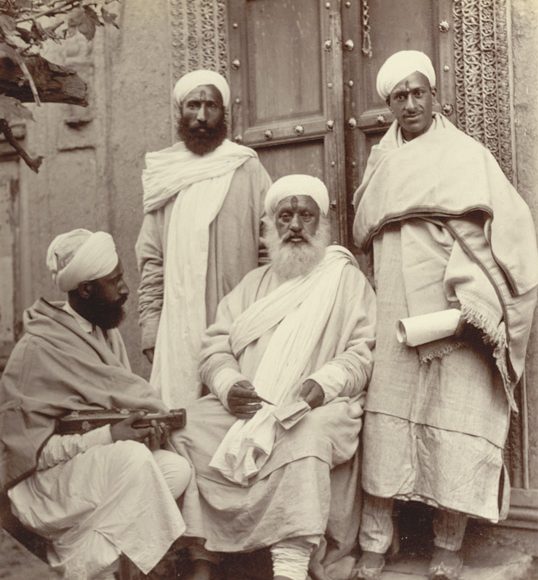GANGA RAM, DIWAN (1775-1826) was a Kashmiri Brahman whose father, Kishan Das, was a government employee. During the oppressive days of the governors of Kashmir, Kishan Das migrated to Delhi, and later settled in the village of Rampur, near Banaras, where Ganga Ram was born about the year 1775. Ganga Ram received a good education and, at the age of 20, entered the service of Maharaja Daulat Rao Scindia of Gwalior, serving under his French officers, Louis Bourquin and General Perron.
He was entrusted with duties in the political and military departments. When in September 1803, Lord Lake defeated Daulat Rao Scindia, Ganga Ram returned to Delhi where he lived from 1803-13. In 1809, he was employed by the East India Company to serve under Colonel David Ochterlony, then engaged in the settlement of British relations with the cis Sutlej states.
In 1813, Maharaja Ranjit Singh invited him to Lahore and gave him appointment as the head of military accounts and keeper of the privy seal. In 1821, Ganga Ram was given charge of the civil administration of Gujrat. Two years later he was recalled to Lahore to reorganize the department of a Bkari excise. Ganga Ram died at Lahore in 1826.
References :
1. Suri, Sohan Lal, `Umdat-ut-Twarikh. Lahore, 1885-89
2. Griffin, Lepel, and C. F. Massy, Chiefs and Families of Note in the Punjab. Lahore, 1909
3. Kohli, Sita Ram, ed., Zafarnamah-i-Ranjit Singh. Lahore, 1928
Ganga Ram Raina (Later Dewan Ganga Ram)
Pandit Ganga Ram was the son of Pandit Kishan Das who had walked down from the Rainawari area of Kashmir to Benaras following the establishment of the Afghan regime in Kashmir. He was the fountain-head contributing to the collection of talented Kashmiri Pandits at the court of Ranjit Singh.
Ganga Ram had joined the court of Mahadji Scindia towards the end of the 18th century when the ruler of Gwalior was engaged in extending the boundaries of his domain. Due to his loyalty and honesty, Ganga Ram distinguished himself and was entrusted with many important political affairs. The Maharaja had recruited French officers to train his military, a procedure foreshadowing that to be undertaken later by Ranjit Singh. Under General Perron, who was a military advisor to Mahadji Sindia, was one Colonel Louis Burquien, and the Colonel was so impressed with Ganga Ram, that he entrusted him with many political assignments including the collection of tribute and drawing up treaties with allied states around Gwalior.
When Daulat Rao, grand nephew of the Mahadji Scindia, began to campaign against the British, Ganga Ram left the Maratha service and purchased a house for 1100 rupees in Sita Ram Bazaar of Old Delhi. Later in 1803, Burquien was defeated by the British under Lord Lake in the battle fought in the Patparganj area of Delhi, which at that time was a dense forest on the outskirts of East Delhi, It was then that Ganga Ram went back to Sitaram Bazaar in Delhi, and made it his home for the next 10 years.
In 1809, when the British General David Ochterlony was negotiating the Treaty of Lahore, formalizing the relations between the British Government and the Phulkian cis Satluj states, Ganga Ram’s assistance was of great value to the General.
Four years later when Maharaja Ranjit Singh was looking for talented people to run the political affairs of his state, he heard of Ganga Ram through Bhai Lal Singh and Sardar Himmat Singh Jallawasia. So in, March 1813, Ganga Ram left Sita Ram Bazaar on the invitation of Maharaja Ranjit Singh and joined him at Lahore. On his arrival at the court of the Maharaja, Ganga Ram presented the Maharaja with a pitcher of Ganga water. The Maharaja made arrangements for the stay of Ganga Ram at the Kashmiri Mohalla in the walled city of Lahore. The Maharaja entrusted him with his (Maharaja’s own) seal to be used in his capacity as head of the military office. He was also made the paymaster of the irregular forces of various chiefs under the patronage of the Maharaja. One Bhawani Das had held this post earlier. These events are recorded in the “ZafarNama ”, a history book written by Dewan Amar Nath Madan, son of Raja Dina Nath Madan. This book deals with the events during the time of Maharaja Ranjit Singh. This was the first reference book on Ranjit Singh’s history during his rapid rise to power. The British at that time used to consult it as a reference book.
About this time, or a little earlier, Hyder Ali in Mysore, Mahadji Sindia in Gwalior and Jaswant Rao Holkar had all realised the necessity of transforming the traditional military technology in order to survive or at least to stave off the British. Only Ranjit Singh was able to make effective use of this knowledge, although this advice was given to him by Holkar.
Ganga Ram obtained considerable power and position, when he impressed the Maharaja by his sheer ability, diligence and knowledge. He was made the Governor of Gujarat District in 1821 for a few years. During this period he developed the Akbari system of accounting which was further improved by one Brahmin Ralia Ram. Dewan Ganga Ram died five years later in 1826.
Ganga Ram later brought with him to the Laore court a number of highly intelligent Kashmiri Pandits, notably three young men Dina Nath, Ajudhya Prasad (adopted son of Dewan Ganga Ram) and Lachman Prasad Thullal (later on Thulal Atal) (real brother of Ajudhya Prasad) who had earlier been trained by him at Sita Ram Bazaar in the art of political diplomacy as well as proficiency in handling military accounts. They were also multilingual, which at that time was a rare quality at all the courts and which allowed them to be interpreters between the Maharaja and the important visiting European and other dignitaries.



